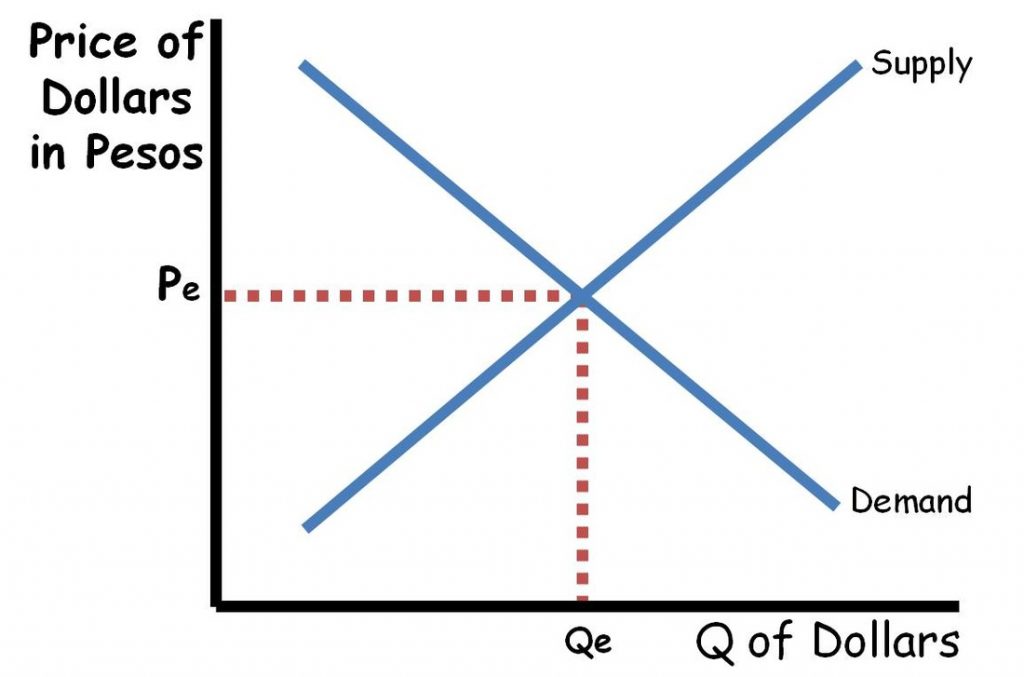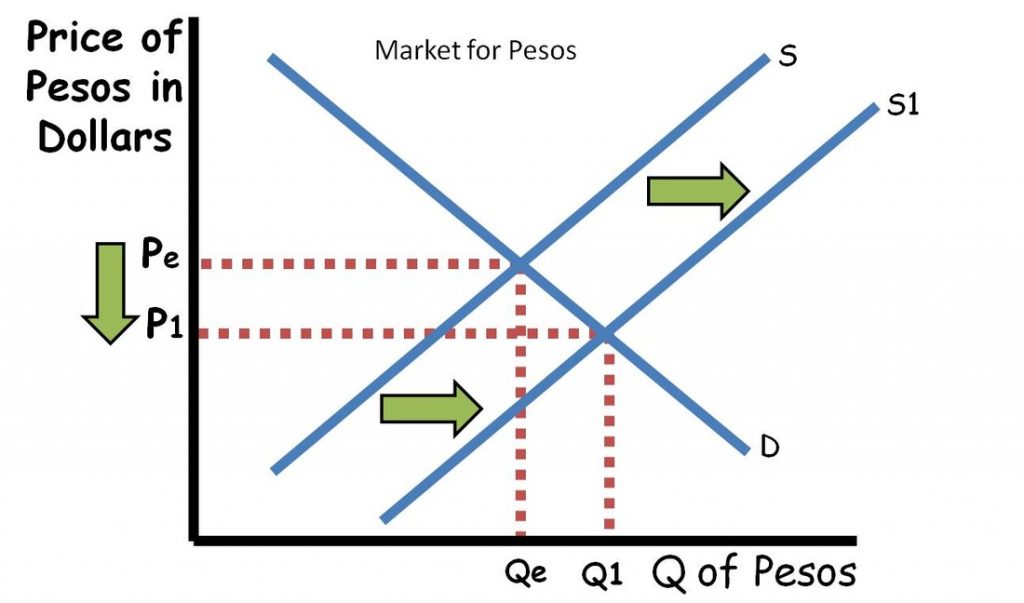Foreign exchange market in international economics – In the intricate world of international economics, the foreign exchange market stands as a pivotal force, shaping the flow of trade, investment, and capital across borders. This market, where currencies are bought and sold, plays a crucial role in determining the value of goods, services, and assets, making it a subject of utmost importance for businesses, investors, and policymakers alike.
From the bustling trading floors of financial centers to the intricate calculations of central banks, the foreign exchange market is a dynamic and ever-evolving landscape. Its participants, ranging from multinational corporations to individual investors, engage in a continuous dance of currency exchange, driven by a complex interplay of economic, political, and psychological factors.
Foreign Exchange Market Overview: Foreign Exchange Market In International Economics
:max_bytes(150000):strip_icc()/Exchange-Rate-1b1df02db6a14eee998e1b76d5c9b82d.jpg)
The foreign exchange market, also known as the forex market or currency market, is a global, decentralized marketplace where currencies are traded. It is the largest financial market in the world, with a daily trading volume of trillions of dollars. The foreign exchange market plays a crucial role in international economics, facilitating global trade and investment.
Participants in the foreign exchange market include central banks, commercial banks, investment banks, hedge funds, and retail traders. These participants use the market to exchange currencies for various reasons, such as facilitating international trade, managing foreign exchange risk, and speculating on currency movements.
The instruments traded in the foreign exchange market include spot currencies, forward currencies, currency futures, and currency options. Spot currencies are currencies that are traded for immediate delivery, while forward currencies are currencies that are traded for delivery at a future date. Currency futures and currency options are contracts that give the buyer or seller the right, but not the obligation, to buy or sell a certain amount of currency at a specified price on a specified date.
Factors Influencing Exchange Rates
Exchange rates are influenced by a multitude of economic and non-economic factors that affect the demand and supply of currencies in the foreign exchange market. These factors can be broadly categorized into two groups:
- Economic factors
- Non-economic factors
Economic Factors
Economic factors that influence exchange rates include:
- Interest rates: Higher interest rates in a country make its currency more attractive to foreign investors, leading to an appreciation in its value.
- Inflation: Higher inflation erodes the purchasing power of a currency, making it less desirable and leading to a depreciation in its value.
- Economic growth: Strong economic growth in a country indicates a healthy economy, making its currency more desirable and leading to an appreciation in its value.
- Balance of payments: A country with a positive balance of payments has a higher demand for its currency, leading to an appreciation in its value.
Non-Economic Factors
Non-economic factors that influence exchange rates include:
- Political events: Political instability or uncertainty can lead to a depreciation in a country’s currency as investors seek safe havens.
- Government policies: Changes in government policies, such as tax laws or regulations, can affect the attractiveness of a country to foreign investors and impact its currency value.
- Market sentiment: The overall sentiment in the foreign exchange market can influence exchange rates. If investors are optimistic about a particular currency, they may buy it, leading to an appreciation in its value.
Exchange Rate Regimes
Exchange rate regimes refer to the framework within which a country’s currency is managed against other currencies. There are three main types of exchange rate regimes: fixed, floating, and managed float.
Fixed Exchange Rate Regime
In a fixed exchange rate regime, the value of the domestic currency is pegged to a specific value, typically that of a major currency like the US dollar or the euro. This means that the central bank intervenes in the foreign exchange market to maintain the fixed exchange rate.
Advantages:
- Stable exchange rates reduce uncertainty and risk for businesses and investors.
- Prevents sharp fluctuations in the currency’s value, which can be disruptive to trade and economic growth.
Disadvantages:
- Can lead to loss of monetary policy independence, as the central bank must prioritize maintaining the fixed exchange rate over domestic economic objectives.
- May require significant foreign exchange reserves to defend the fixed rate, which can be costly and unsustainable in the long run.
Examples: Saudi Arabia, Hong Kong
Floating Exchange Rate Regime
In a floating exchange rate regime, the value of the domestic currency is determined by the forces of supply and demand in the foreign exchange market. The central bank does not intervene to influence the exchange rate.
Advantages:
- Allows the exchange rate to adjust to changes in economic fundamentals, such as inflation, interest rates, and trade flows.
- Provides monetary policy independence to the central bank, allowing it to focus on domestic economic objectives.
Disadvantages:
- Can lead to exchange rate volatility, which can be disruptive to trade and investment.
- May require significant foreign exchange reserves to smooth out fluctuations in the exchange rate.
Examples: United States, United Kingdom
Managed Float Exchange Rate Regime
In a managed float exchange rate regime, the central bank intervenes in the foreign exchange market to influence the exchange rate, but within a target range or band. This allows for some flexibility while maintaining a degree of stability.
Advantages:
- Combines the advantages of both fixed and floating exchange rate regimes.
- Provides some stability while allowing the exchange rate to adjust to economic fundamentals.
Disadvantages:
- Can be difficult to manage and requires significant foreign exchange reserves.
- May lead to exchange rate volatility if the central bank’s interventions are ineffective or unpredictable.
Examples: China, Brazil
Foreign Exchange Intervention

Central banks play a crucial role in foreign exchange markets by intervening to influence exchange rates. Intervention involves buying or selling foreign currencies to affect their value relative to the domestic currency.
Central banks use various methods to intervene in the market, including:
Open Market Operations
- Buying or selling foreign currencies in the spot market to directly impact the exchange rate.
- Example: If a central bank wants to weaken the domestic currency, it can sell foreign currencies in the spot market, increasing the supply of foreign currencies and reducing their value.
Forward Market Intervention
- Buying or selling foreign currencies in the forward market to influence future exchange rates.
- Example: If a central bank expects the domestic currency to depreciate, it can sell foreign currencies forward, locking in a higher exchange rate for future transactions.
Currency Swaps
- Exchanging domestic currency for foreign currency with another central bank or financial institution, with an agreement to reverse the transaction at a future date.
- Example: A central bank can swap domestic currency for foreign currency with a higher interest rate to attract foreign investment and appreciate the domestic currency.
Verbal Intervention
- Issuing public statements or giving interviews to influence market expectations and guide exchange rate movements.
- Example: A central bank governor may announce that they are prepared to intervene if the exchange rate exceeds a certain level.
Hedging and Risk Management
Hedging is a financial strategy used to mitigate risk and reduce uncertainty in international business. It involves taking an opposite position in the foreign exchange market to offset potential losses from fluctuations in currency exchange rates.
Examine how jelaskan yang dimaksud foreign exchange market can boost performance in your area.
There are various hedging instruments available, each with its own advantages and disadvantages. Common instruments include:
Forward Contracts
- Legally binding agreements to exchange currencies at a predetermined rate on a future date.
- Provide certainty in future exchange rates, eliminating uncertainty.
- Example: A U.S. company importing goods from Japan can use a forward contract to lock in the yen-dollar exchange rate, protecting against potential appreciation of the yen.
Currency Options
- Contracts that give the buyer the right, but not the obligation, to buy or sell a currency at a specified price on or before a certain date.
- Offer flexibility and potential profit opportunities, but also carry a premium.
- Example: A European company exporting to the United States can purchase a call option to protect against a potential depreciation of the euro against the dollar.
Currency Swaps
- Agreements to exchange currencies at a predetermined rate for a specified period, with a reversal of the transaction at the end of the period.
- Allow companies to manage long-term currency exposure and interest rate risk.
- Example: A Japanese company with a subsidiary in the United States can use a currency swap to convert yen into dollars and hedge against currency fluctuations.
Impact on International Trade
Exchange rate fluctuations can significantly impact international trade by affecting the competitiveness of exports and imports.
When investigating detailed guidance, check out define global foreign exchange market now.
Currency appreciation, or an increase in the value of a currency, makes exports more expensive and imports cheaper. This can lead to a decrease in exports and an increase in imports, resulting in a trade deficit.
Browse the multiple elements of role of rbi in foreign exchange market pdf to gain a more broad understanding.
Currency Appreciation
- Exports become more expensive for foreign buyers, reducing demand.
- Imports become cheaper, increasing demand from domestic consumers.
- Can lead to a trade deficit (more imports than exports).
Conversely, currency depreciation, or a decrease in the value of a currency, makes exports cheaper and imports more expensive. This can lead to an increase in exports and a decrease in imports, resulting in a trade surplus.
Currency Depreciation
- Exports become cheaper for foreign buyers, increasing demand.
- Imports become more expensive, reducing demand from domestic consumers.
- Can lead to a trade surplus (more exports than imports).
Exchange rate fluctuations can also impact the terms of trade, which refers to the ratio of export prices to import prices. A favorable terms of trade occurs when export prices are higher than import prices, while an unfavorable terms of trade occurs when export prices are lower than import prices.
Impact on Investment and Capital Flows

Exchange rate fluctuations significantly impact foreign direct investment (FDI) and capital flows. Stable exchange rates foster confidence among investors, encouraging them to invest in foreign markets. Conversely, volatile exchange rates increase uncertainty and risk, potentially deterring investment.
Currency Stability and Investment Decisions, Foreign exchange market in international economics
Currency stability provides a predictable environment for investors, reducing the risk of losses due to exchange rate fluctuations. This stability encourages long-term investment and capital inflows, as investors are more confident in the stability of their returns. Conversely, exchange rate volatility creates uncertainty and can lead to capital outflows as investors seek safer havens for their investments.
Final Review
In conclusion, the foreign exchange market is a multifaceted and dynamic force that exerts a profound influence on the global economy. Its complexities and intricacies present both opportunities and challenges for businesses, investors, and policymakers. By understanding the factors that shape exchange rates, the different exchange rate regimes, and the techniques for hedging currency risk, we can navigate this complex landscape and harness its potential to drive economic growth and prosperity.
